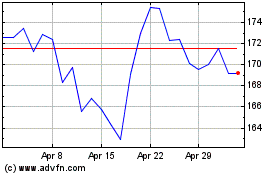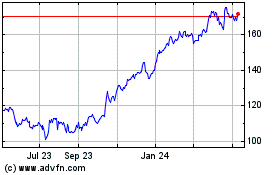MetLife, Allstate Post Strong Gains in Adjusted Earnings -- 2nd Update
May 05 2021 - 7:18PM
Dow Jones News
By Leslie Scism
MetLife Inc. and Allstate Corp. posted strong gains in adjusted
earnings as the insurers weathered another quarter of the Covid-19
pandemic.
Allstate's car-insurance business had a strong quarter as
rush-hour fender-benders were below normal, with many Americans
still working from home rather than commuting. MetLife had sharply
higher death benefits on life-insurance policies while payouts on
pension products and other annuities were reduced.
"We believe the worst impact of the pandemic on our business
performance is behind us," MetLife Chief Executive Michel Khalaf
said.
The pandemic's impact on the insurance industry hasn't been as
bad as was feared when Covid-19 cases started climbing just over a
year ago. Car insurers got windfall profits as stay-at-home
directives and business shutdowns left vehicles parked for days.
While death claims are elevated, U.S. life insurers have paid fewer
claims than initially expected per 100,000 Covid-19 fatalities,
largely because the virus has disproportionately killed the elderly
and other people with little to no insurance.
MetLife's net income fell 93% to $290 million, a decline
primarily related to mark-to-market losses on the financial hedges
it buys to protect the company from falling interest rates and
stock markets. When rates and equities rise, as they did in the
first quarter, the value of that protection falls. Still, MetLife's
reported results got a lift from improved market conditions.
Wall Street analysts largely look past those swings and focus on
adjusted earnings, which strip out items considered nonrecurring.
On that basis, MetLife reported a 36% surge to $1.97 billion. Much
of the improvement came from unusually strong returns from
private-equity holdings in the company's huge investment portfolio.
It has a tiny percentage of such holdings, but they helped fuel a
74% gain from the year-earlier period to $5.31 billion in net
investment income.
Allstate posted a net loss of $1.41 billion, a reversal from net
income of $513 million in the year-earlier period. The results
reflected an aggregate net loss of about $4 billion in the quarter
from previously announced agreements to sell a pair of life and
annuity insurers.
Allstate's adjusted net income rose 56% to $1.87 billion. The
improvement came even as catastrophe losses more than doubled, to
$590 million from $211 million.
A big part of the improvement came from the auto-insurance
business, thanks to "decreased accident frequency and a lower
expense ratio," the company said.
Miles driven across the U.S. "is headed up to pre-pandemic
levels, but not always at the same time of day" as people used to
drive, Allstate Chief Executive Tom Wilson said in an interview.
"It looks like we are coming out of the reduction in auto accidents
slowly, but nobody knows where it is going" as Americans return to
their workplaces. "You could surmise that as the country gets back
to work, it will go back up."
Allstate, which is also one of the nation's biggest home
insurers, was among property insurers hit with large claims volume
from the long stretch of frigid February weather in Texas and
numerous other states. The unusual weather across Southern states
caused widespread freezing and burst pipes, leading to extensive
water damage.
Industrywide, property insurers face an estimated $18 billion
bill for the cold-weather damage to homes and businesses, the
equivalent cost of a major hurricane, according to a risk-modeling
firm, Karen Clark & Co.
Like its rival Prudential Financial Inc., MetLife experienced
higher costs in this year's first quarter, compared with the year
before, in its business of selling life insurance to employers'
benefits programs.
Both Prudential and MetLife have large retirement-income
businesses that have benefited as pensioners and owners of
annuities have died prematurely, the companies' results show.
Prudential reported its first-quarter results Tuesday. It said
its group-insurance business lost $132 million in the first quarter
on an adjusted basis, compared with operating profit of $44 million
in the year-earlier period, a decline largely driven by Covid-19
deaths. Its retirement-income business, reported adjusted profit of
$623 million, up from $245 million, "including favorable impacts
due to Covid-19."
Separately, MetLife this week filed a legal response to a U.S.
Department of Labor investigation into its handling of the
carrier's previously acknowledged failure to properly search for
thousands of workers who were owed money as part of its "pension
risk-transfer" business.
MetLife publicly revealed the failure in 2017 and reached
settlements with the New York Department of Financial Services,
Massachusetts Securities Division and the U.S. Securities and
Exchange Commission. It agreed on ways to search for and
compensate, with interest, the missing pensioners.
In the filing in federal court in Manhattan, MetLife maintained
that the information sought by the Labor Department in a January
subpoena "is outside the DOL's jurisdiction" because group
annuities -- the product used to pay the pensions -- are
state-regulated.
The department's court filings state that it is investigating
whether MetLife violated any provisions of federal law. The
subpoena asks for documents tied to "Project Chestnut," MetLife's
name for its effort to find and pay the individuals.
Write to Leslie Scism at leslie.scism@wsj.com
(END) Dow Jones Newswires
May 05, 2021 19:03 ET (23:03 GMT)
Copyright (c) 2021 Dow Jones & Company, Inc.
Allstate (NYSE:ALL)
Historical Stock Chart
From Mar 2024 to Apr 2024

Allstate (NYSE:ALL)
Historical Stock Chart
From Apr 2023 to Apr 2024
